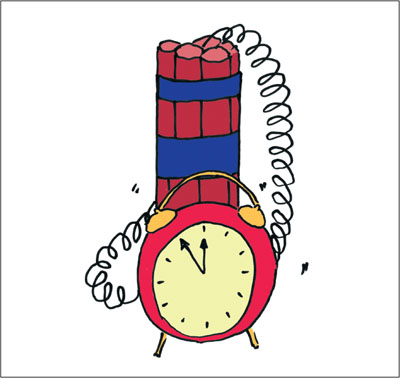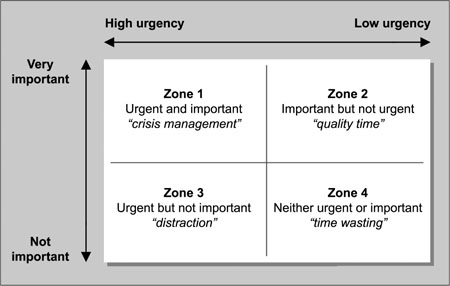Chapter 8
Efficiency and effectiveness
Carole Brennan
Aim
The aim of this chapter is to help the dental team to make best use of time, reduce stress levels, perform well at work and achieve goals.
Outcome
After reading this chapter, readers should appreciate that time is valuable and easily wasted and recognise how time is spent and how to prioritise tasks. There should also be awareness that good time management reduces stress levels and that strategies can be developed to enhance efficiency and effectiveness.
Time
Time cannot be bought, borrowed or manufactured, so there is only ever 60 seconds in a minute, 60 minutes in an hour and 24 hours in a day. Time spent (or wasted) is gone and cannot be retrieved.
The 24 hours in each person’s day is the same as that in everybody else’s day (Fig 8-1), and yet often one can end up feeling short of time, tired, angry, frustrated and stressed. Could it be that you are not using, or do not know how to use, the 24 hours to best advantage? Alternatively, are you unrealistic as to what can be achieved in a day?

Fig 8-1 Time needs management.
Time management refers to the process of actively structuring time in ways that enable the individual to be more productive, with less stress and with increased probability of achieving professional and personal goals.
In the fast-moving society in which we live, we work harder, longer and faster and often with less support than ever before. Mastering time management is not an option, but an essential survival skill in high-pressure situations such as those that exist in busy practices and other clinical environments.
Time can be classified in various ways. In the context of efficiency and effectiveness, time may be considered under the following headings.
→ Time to sell. This is the time which is given over to running a business, sold to an employer or as students given to school, college or university. The pay-off is remuneration, skills, occupational qualifications or education. Sold time goes typically well beyond actual hours worked; it also includes, for example, time spent travelling and working at home.
→ Maintenance time. This is time used to keep things ticking over; time spent in individual maintenance: eating, sleeping, dealing with personal affairs, looking after others and a home.
→ Time to choose. This is the time left over, which is free to be used to pursue interests and relax.
Finding the time
Many of us feel that we do not ‘have the time’. How many times have we heard ourselves, friends and colleagues say: ‘I haven’t had the time to do that yet’. In a profession such as dentistry, whatever the personal goals in life, an individual needs to perform well at work and to create a work-life balance that is sustainable.
The consequences of a work-life balance that is unsustainable, if not out of control, include stress, ill-health, not achieving the things that are important to you, poor performance, neglecting family and friends and not having the time to relax and enjoy life.
Managing time well
To address personal time management, answer ‘true’ or ‘false’ to the following statements:
-
I never seem to have enough time for things
-
I rarely get things done on time
-
I can always find time for myself
-
I always know what I’m doing and why
-
I keep lists of things I need to do
-
I plan my day by setting objectives and priorities.
A person who has learnt to manage time well should be able to answer:
-
False
-
False
-
True
-
True
-
True
-
True.
If your answers were different, even if only in one or two of the questions, then there is a need to develop, or at least improve, your time management skills.
The first step in time management is to know how you are currently spending your time. Once you have a clear picture of this, you can begin to take control of it and start to redirect your time usage towards your goals and their priorities.
Current use of time
There are a number of techniques for analysing how time is being spent. These include activity logs and time management grids, which are discussed below.
Activity logs
Activity logs help you to analyse how you actually spend your time. The first time you use an activity log, you may be shocked to discover how much time you waste or put to no good use.
It is necessary to go through the process of writing everything down, as memory and subjective judgement are a poor substitute for objective data. Keeping an activity log for several days helps you to understand how you actually spend your time, and to identify the times of the day when you perform best.
Completing and analysing your activity log will help you to identify the reasons why, for example, you are always working through lunch, staying late in the evening, not achieving your goals or working on too many things at any one time. Furthermore, you can identify the reasons for your endless ‘busyness’. Is it poor organisation? Is it outdated or malfunctioning equipment that is constantly affecting the smooth running of your day? When you understand who or what is wasting your time, you can take action to regain control of your time management.
It is also important to record in your activity log how you feel at different times, whether alert, flat, tired or energetic, and how much you obtained satisfaction or begrudged doing particular tasks.
With the analysis of your activity log completed, identify time wasted, time doing tasks that were important and necessary, time spent doing tasks that could have waited or been done by someone else, and time spent doing other things.
Once you know how you spent your time, answer the following questions.
-
Does anything surprise you about the way you have spent the last few days?
-
Was there anything unusual about the last few days?
-
What returns are you getting for your time investment: satisfaction, peace of mind, remuneration?
-
Are there any changes you would like to make?
-
Can you identify ways of saving time, to enhance and ideally maximise your returns?
-
Is it necessary to critically review what you expect to achieve in the time available?
Establishing priorities
Having analysed your activity log and answered the questions above, you need to consider the amount of energy you spend on various tasks and whether those tasks justify the effort expended.
Many people spend their days in a frenzy of activity but achieve very little through lack of appreciation and focus on the most important things. Vilfedo Pareto, an Italian economist, developed what is often referred to as the ‘Pareto Principle’, or the ‘80/20 rule’. This states that typically 80% of unfocused effort generates only 20% of results, with the remaining 80% of results being achieved with 20% of focused effort.
In other words, much more can be achieved by increasing the extent to which your efforts are focused.
Time management grid
The time management grid (Fig 8-2) is a useful tool in helping to sort out priorities.

Fig 8-2 Time management grid.
The time management grid focuses on the two key elements of time management: the urgency and the importance of tasks. Along the top of the grid is the urgency axis: the left-hand side of the axis is very urgent and the right-hand side is less urgent. The vertical axis of the grid is the importance axis. The top boxes contain more important activities; the bottom boxes contain activities that are less important. This gives four time zones.
→ Zone 1. This represents things that are both urgent and important, or in other words things requiring ‘crisis management’. These activities must be dealt with immediately. There are times when a crisis occurs which cannot be predicted, or the circumstances for their occurrence are out of your control, for example a medical emergency. All planned work has to be abandoned to manage the crisis. There are times when a task becomes a crisis simply because it was not allocated the appropriate time or priority and dealt with accordingly in a timely fashion.
→ Zone 2. This represents thi/>
Stay updated, free dental videos. Join our Telegram channel

VIDEdental - Online dental courses


